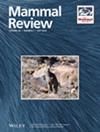新世界有袋类动物的分类评估、保护现状和未来展望
IF 4.4
2区 生物学
Q1 ECOLOGY
引用次数: 0
摘要
新世界有袋类动物(New World Marsupials,NWMs)包括从巴塔哥尼亚(阿根廷)到北美洲北部的超过 135 个物种,被归类为有袋目(Didelphimorphia)、无袋目(Microbiotheria)和有袋目(Paucituberculata)。本研究根据世界自然保护联盟(IUCN)红色名录评估和当前文献,研究了新世界有袋类动物最近的分类学修订和保护优先事项。在 137 个物种中,一半以上(n = 82;60%)的种群趋势仍然不明,其中 34 个物种保持稳定(25%),30 个物种正在减少(22%),只有 3 个物种呈上升趋势(2.2%)。在世界自然保护联盟评估的 105 个物种中,45 个物种(43%)的种群趋势不明。已确定的评估物种(n = 32)面临的威胁包括生态系统转换和退化,这是主要威胁,另外 26 个物种可能因生境破碎化和/或土地转换而丧失生境。在对拟议的分类进行详细分析时,"栖息地丧失、破碎化和转换 "被确定为 61 个物种的主要威胁:我们为 85 个物种(62%)确定了研究需求,涉及五个类别:分类学(9 个物种)、生活史和生态学(75 个物种)、种群数量、分布和趋势(80 个物种)、威胁(78 个物种)和行动(2 个物种):我们提出了加强保护的四个关键步骤:1)更新评估,纳入所有有效物种;2)确定保护野生动物的优先区域;3)鼓励研究合作;4)将数据纳入不同空间和政治尺度的保护战略。本文章由计算机程序翻译,如有差异,请以英文原文为准。
Taxonomic assessment, conservation status, and future perspectives for New World Marsupials
求助全文
通过发布文献求助,成功后即可免费获取论文全文。
去求助
来源期刊

Mammal Review
生物-动物学
CiteScore
12.20
自引率
4.10%
发文量
29
审稿时长
>12 weeks
期刊介绍:
Mammal Review is the official scientific periodical of the Mammal Society, and covers all aspects of mammalian biology and ecology, including behavioural ecology, biogeography, conservation, ecology, ethology, evolution, genetics, human ecology, management, morphology, and taxonomy. We publish Reviews drawing together information from various sources in the public domain for a new synthesis or analysis of mammalian biology; Predictive Reviews using quantitative models to provide insights into mammalian biology; Perspectives presenting original views on any aspect of mammalian biology; Comments in response to papers published in Mammal Review; and Short Communications describing new findings or methods in mammalian biology.
 求助内容:
求助内容: 应助结果提醒方式:
应助结果提醒方式:


